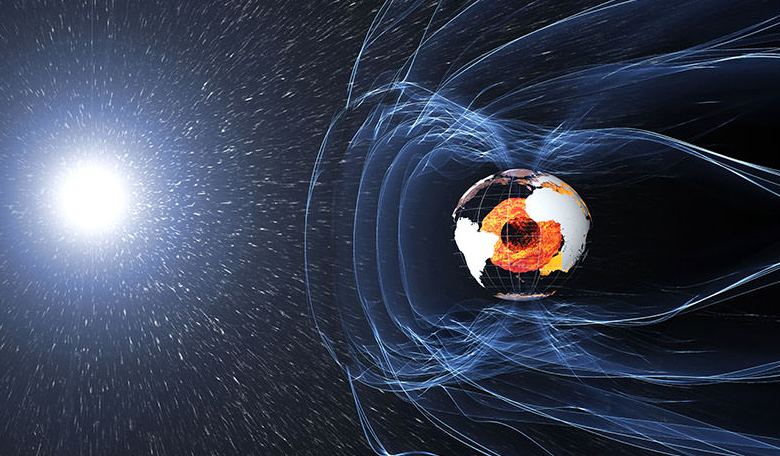An analysis of rock samples from ancient lava flows in Eastern Scotland has provided further evidence that Earth’s magnetic field weakens in strength approximately every 200 million years; a finding which has implications for life on our planet.
Around 372 to 359 million years ago, records show that a huge loss of diversity occurred on Earth; marine life was most effected, but plants and pollen were also hit badly too.
The period is referred to as the Devonian-Carboniferous mass extinction and some consider the extinction to be separated into distinct events, spread over millions of years.
Despite uncertainties in the timespan of these events, studies suggest that the mass extinctions are linked to an increase in ultraviolet (UV) radiation that damaged and mutated DNA, that in turn caused widespread disruption in all parts of the ecosystem.
How could UV radiation increase to such a level that 70-82 percent of all marine species were wiped out?
A few years ago, a team of researchers suggested that rapid reversals in the direction of Earth’s magnetic field was to blame.
Although evidence was found to suggest the reversal rate back then was 20 times faster than it is today, it wasn’t the flip rate that was necessary the problem, but a weakening of the magnetic field strength instead.
When Earth’s magnetic field is weakened, the drop in strength allows more energetic particles into the upper atmosphere, which results in a break down of the ozone layer.
The stratospheric ozone layer is Earth's “sunscreen” and without one, there is nothing to help shield life on Earth from harmful UV radiation.
Evidence of magnetic flips can be found in the rock records, but finding proof of a weakened field strength is much more difficult. However a team of researchers at the University of Liverpool in the UK have found a way using palaeomagnetism.
Palaeomagnetism is the study of Earth’s magnetic field produced in the outer core (at a depth of 2,890 kilometres) millions to billions of years ago and preserved in rocks formed at the surface at that time.
Deciphering variations in past geomagnetic field strength is important as it indicates changes in deep Earth processes over hundreds of millions of years and could provide clues as to how it might fluctuate, flip or reverse in the future.
Using a thermal and microwave paleomagnetic analysis – a technique which is unique to the University of Liverpool – the team has been able to measure the strength of the geomagnetic field in rock samples from ancient lava flows in Eastern Scotland during key time periods.
The team, headed by Louise Hawkins, found that between 332 and 416 million years ago, the strength of the geomagnetic field preserved in these rocks was less than quarter of what it is today.
It is also similar to a previously identified period of low magnetic field strength that started around 120 million years ago. The researchers have coined this period “the Mid-Palaeozoic Dipole low (MPDL).”
“This comprehensive magnetic analysis of the Strathmore and Kinghorn lava flows was key for filling in the period leading up the Kiaman Superchron, a period where the geomagnetic poles are stable and do not flip for about 50 million years,” Hawkins says.
The Kiaman, also known as the Permo-Carboniferous Reverse Polarity Superchron, occurred around 262–318 million years ago (Ma), and is named after lava flows in Kiaman, Australia, where it was first identified.
Hawkins’ and colleagues samples are from lava flows at Strathmore and Kinghorn in Scotland and date from ∼411 to 416 Ma and ∼332 Ma respectively.
When considered alongside the existing datasets, the team’s research supports the existence of an “approximately 200-million-year long cycle in the strength of the Earth’s magnetic field related to deep Earth processes”, Hawkins says. Whats more, our findings also provide further support that a weak magnetic field is associated with pole reversals, she adds.
As the dates of low magnetic field strength also coincide with the Devonian-Carboniferous mass extinction event, it adds weight to the theory that strong UV radiation exposure over long periods was the cause, or one of the causes, for the huge loss of life during this period.
The team’s research, Intensity of the Earth's magnetic field: Evidence for a Mid-Paleozoic dipole low, is now published in Proceedings of the National Academy of Sciences.











